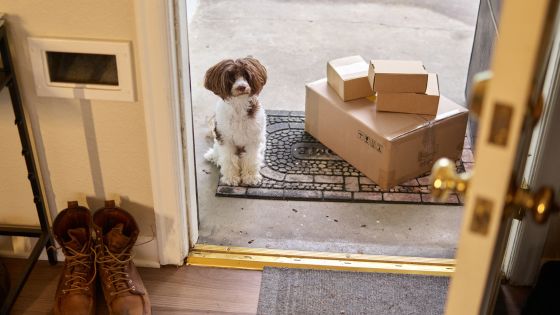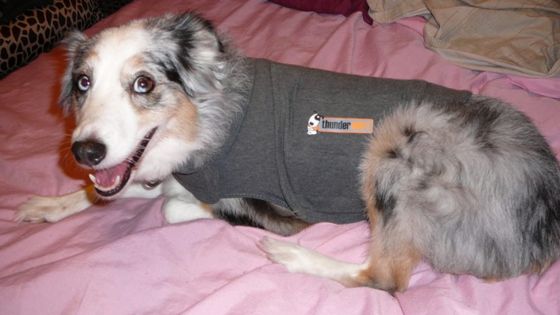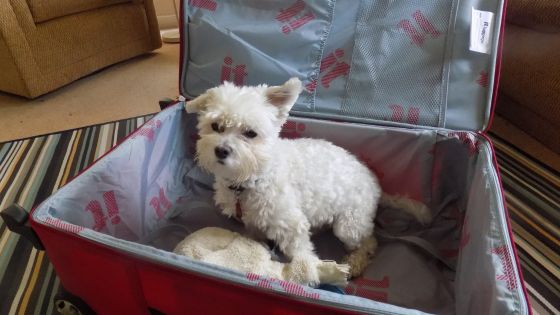Moving is stressful no doubt about it, but did you know it’s up there with job loss, marriage, divorce and death?
I’ve moved a lot, but that’s what happens when you have wanderlust, and most of that moving was done with dogs and cats in tow. Yes, they were usually seniors!! I’ve moved apartments in the same city, moved to different countries and even continents. Needless to say I’ve learned a few things along the way, so I thought I’d share my words of wisdom.
Naturally I’m focusing on senior dogs as I write, but these tips will work no matter how old or what type of pet you share your life with. They will also help whether you’re moving to another apartment in the same building or to another country.
*There are affiliate links in this post, which means if you purchase anything I make a few pennies…literally. It does not affect the price you pay.*
They Know!
I find it incredible how animals have an uncanny ability to sense when something is up, and I have witnessed it enough times that I know it to be true. What’s most amazing to me is how they seem to know you’re going to move even when it’s just an idea…before the M word has even been uttered.
I didn’t even have to bring a box into the house for them to start acting all weird!
Then the Disruption Starts
- That schedule you’re so proud of is but a distant memory
- Meal times may turn into “whenever I remember” (okay not really but you know what I mean!)
- A walk is “squeezed in”
- Evenings snuggling up on the couch are nothing more than a happy memory (for humans and pets!)
I’d like to think I’m being a bit melodramatic, but as moving day nears it’s not an uncommon scenario.
Yes it would be great if schedules could be followed but that’s not entirely realistic, so the only thing we can do is the best we can do. Don’t beat yourself up, you’re doing a great job.
The good news is there are ways to minimise a move’s effect on our animals, which I believe to be particularly important if they are elderly and/or have anxiety or other health issues.
BEFORE THE MOVE
Here they are, in no particular order
Bring out the suitcases: Get your dog used to seeing boxes and suitcases a good couple of weeks before you’ll start packing them, by leaving them out for him to explore. If possible bring them in one or two at a time. Don’t make a big deal about them, and when he starts to sniff around and he’s calm, reward him with a favorite treat. It will get him used to seeing them before the commotion starts.
Have a support system: Make arrangements for your dog’s care when you’re too busy, or you need to get him out of the house because potential buyers will be dropping by. Ask friends, family and neighbors if you can call on them, perhaps even at the last minute. Connecting with a dog walker or two is a good idea, as is checking out day care facilities should you need a safe place for a few hours.
Stick to their schedule as best you can: Do what you can to stick to their schedule of meal times and exercise. Many old dogs are sensitive to changes in schedule, particularly those with dementia or anxiety, and that can be a stressor in itself. If your dog is on medication, it’s even more important to watch that clock! If at times you need a hand, call on that support system. You also need a break, so going for a walk with the dog is a de-stressor for you as well.
Pack a “go” bag: I know from experience, there are times a realtor will call with a last minute request to show your home. Keep a knapsack packed with water, bowls, treats and a favourite toy so you can grab and go.
Update tags and microchip: Double check that microchip and tag details are up to date, and have a tag with your new contact details made and ready to use. Don’t forget to update the microchip with your new address.
Play dog calming music: Start playing a CD of dog calming music now, I mean right now…okay when you finish reading!! When you find the ones he relaxes to, those are the ones you will play while packing because it will remind him of the relaxed state he felt. The two that work best for my dog are Through a Dog’s Ear and Relax My Dog. There is a 13 minute sampler of the first on Youtube, and the second has hours of free music to play.
Try Adaptil: This dog calming plug in is worth a try, as it may help relax your dog while things are in a state of flux.
Dogs and open houses: An open house is not a place for a senior dog, or any pet for that matter. If you won’t be hanging around then no problem, you and your dog can enjoy a day out. If you want to be a part of it, call on your support system.
Consider doggie daycare: Put him in doggie daycare for a couple of hours and see what he thinks. If he likes it, you now have a place to take him when you’re busy, or he needs to be out of the house. Make sure you do your research and the place is appropriate for an elderly dog.
Pack dog supplies separately: All the dog stuff should go in a clearly labelled box so when you reach your new home, you can unpack it first and get him settled right away.
Schedule viewings around your dog’s schedule: If possible, ask the realtor to come by with buyers during your dog’s walk time. It allows him to stick to his schedule as much as possible, and the less often he sees strangers traipsing through his home the better. Obviously it won’t always be possible and you certainly don’t want to miss out on a sale, so for those times call on your trusted support system.
Pack the dog stuff last: Pack up your dog’s favorite bed, crate, toys and blankets at the last possible moment. You want him to feel safe and comfortable for as long as possible.
Car safety: If you will be driving to your new home and it’s quite a long distance, I recommend you keep a harness on your dog throughout the trip. If he’s never worn one before now is the time to start getting him used to it. Rest stops can be hectic and new surroundings frightening, so don’t take a chance of him panicking and slipping out of his collar. I also recommend investing in a seatbelt, crate or travel bag when in the car.
Pack a dog bag for the car: Pack a separate bag just for your dog of all the things you’ll need during the trip. Trust me it’s easier than rooting around yours. Don’t forget –
- Medical records
- Pet passport/paperwork if crossing borders
- Medication for the trip plus a few days extra
- Food for the trip plus a few days extra
- Large bottle of water
- Favorite toy
- Blanket
- Food and water bowls
Play dog calming music: If your dog is anxious, think about playing calming music during the drive. A word of warning – be careful because it may relax you so much you’ll fall asleep…I’m not kidding. When I played Through a Dog’s Ear for Red, I ended up snoozing and that’s on the couch! You may also want to play it in the house during the packing process to help keep him calm.
Make a list of vets and emergency hospitals: If you’re moving out of your area, find out where the nearest 24 hour emergency hospital is. I also recommend starting a search for some possible vets you’ll want to check out when you arrive. Having some contact numbers is a wise precaution should your dog be feeling unwell after the journey. If you’re driving a long distance, I would take note of vet practices and hospitals along the way.

DURING THE MOVE
Not all tips will be relevant as so much depends on how you’ll be travelling and where you’re going, and as before they are in no particular order.
Helping your anxious dog: If your senior dog is suffering from anxiety and takes comfort in your presence, try and keep him with you even through the upheaval. Of course you’re the best judge so if you don’t feel it’s a good idea, reach out to one of your support group until you’re ready to go. Even if they just take him for a walk in the neighborhood, it can help keep him calmer.
Put the new dog tag on: As soon as you start your journey, put the new dog tag on the collar. Until you reach your destination I would leave both of them.
Stick to the schedule when possible: It would be wonderful if you could keep to your dog’s schedule during the actual move, but depending on how you’re getting to your new home, that may not be possible. If you’re driving you could plan rest stops around the same time as feeding and walking times, but no one can expect you to be bang on schedule. Of course if you’re flying, especially if your dog is in cargo, that just won’t be possible.
Who’s responsible for the dog: Have one person responsible for watching the dog when the movers are there. Not possible? Put him in a crate in a room no one has to go into. If a crate is not an option, ask someone you trust if you can bring him over, or put him in doggie day care for a few hours.
Safety at rest stops: Some rest stops are crazy busy, but if you have to stop for gas you have to stop for gas. Some turn offs are quiet areas with nothing but a bathroom if that, so aim to stop there when it’s time to feed and walk the dogs. If “busy” is the only option, park as far away from other cars as possible, and try and find a quiet spot. Make sure the harness is on and do the best you can!
Bring what gives him comfort: Have his favorite bed, blanket and a couple of toys with him in the car. If he’s flying, you can put his blanket in the crate.
Have water at the ready: Keep your dog well hydrated throughout the journey. If he’s flying in cargo, half fill the water container then freeze it. Staff will add water before the crate is loaded onto the plane, so the melting ice should give him enough to drink during the flight.
Dress for the weather: If it will be cold and/or rainy, don’t forget to pack a sweater and coat.
Don’t forget the cuddles: Some cuddle time is definitely in order during the car ride, so you may have to spend time in the back seat.

Car safety: It’s dangerous to let your dog remain loose during a car ride, no matter how long or short the ride is. In many places it’s also illegal and you can be fined like I discovered while driving in Spain. Keep him safe by putting him in a crate, carrier or clipping a doggie seatbelt to his harness. You can see what I did in the picture when I was driving with my dogs. Red was in her carrier bag, Jack was wearing his harness and attached to a seatbelt.
AFTER THE MOVE
Exciting! Overwhelming! Where do I even begin! Perfectly natural reactions when entering your new home. Don’t worry everything will fall into place.
Back to the schedule: Your dog’s routine and schedule resume the minute you walk through the door. He may be in unfamiliar surroundings, but at least his schedule will be familiar.
Limit access: I don’t recommend you give your dog free access in your new home right away. It’s unfamiliar, strange and can be unnerving. Accidents in the house are not a good start, and with the door opening and closing he can easily get out and lost in a new neighbourhood, never mind country. Keep him with you on a leash until things settle, and he will feel comforted being close to you.
Set up a spot for your dog: Set up a corner for your dog right away with his favorite bed, blanket, and toys. Show him the water bowl, plug in the Adaptil if it worked and play the calming CD.
Create a safe space: When you have to go out, block off your dog’s area until he has settled in. The smaller space will help him feel safer. If he’s been crate trained even better. What about leaving the crate out with the door open so he has a hidey hole to escape to!
Skip the laundry: Don’t wash the dog’s blankets quite yet. Familiar smells may put him at ease and help him settle faster. I’m stating the obvious by saying if he’s peed all over it/them, this suggestion doesn’t apply!!
No parties yet please: Resist the urge to throw a housewarming party right away, or spend evenings out establishing a social life. Of course you want to settle in and make friends, just be sure to spend time with your dog as well.
Walk when it’s quiet: When first walking in your new neighbourhood, aim for quiet times if possible. If you live in the heart of a very busy city there’s not a lot you can do, unless you find a less busy time of day. Use the harness!!
Keep doing what your dog loves: If you used to enjoy going to a local café and sitting together outside watching the world go by, keep up that fun tradition.
Don’t do what your dog doesn’t like: Avoid doing the things your dog hates right away. For example, if he hates taking a bath, don’t throw him (I don’t mean that literally!!) into the tub on your first day in the new home. That’s bound to cause tons of anxiety, and maybe even create negative associations.
Don’t leave him outside: Be mindful about leaving him out in the yard alone while still getting settled, unless there’s no way he can get out. Some dogs may try and escape back to their old homes, even if they don’t yet realise they’re in a different country!!
Stay home with him for a bit: If possible, help your senior adjust by not going back to work or starting your new job the next day.
ADDITIONAL STRESS BUSTING TIPS
I may have mentioned some of these stress busting tips above, but I wanted to create this section specifically to highlight some of the options you have to choose from. Not every suggestion will work for every dog, it’s likely going to be a case of trial and error.
Anti anxiety medication
There are medications your vet can prescribe to take the edge off, but sometimes you have to play around with dosages until it works. It goes without saying, although I’m going to say it anyway, don’t experiment, get guidance from your vet.
If you prefer something more natural keep reading…
Relaxing music

When my senior dog Red started pacing and not settling for hours, and before I realised it was dementia, I was struggling to find something to calm her down. I discovered a cd called Through a Dog’s Ear, and it was remarkable. Within seconds of playing it she would relax and fall asleep. You can see her in the picture above, taken right after listening to this music. It is engineered to help relax anxious dogs, no matter the cause, and it’s absolutely worth a try. There is a 13 minute sampler on Youtube so you can see if it works before you buy.
The second thing I tried for her was called Relax My Dog, again on Youtube and there are several to choose from.
A word of caution – if you’re playing it in the car, be careful it doesn’t make you drowsy. When I played Through a Dog’s Ear for Red I usually ended up having a snooze it’s so relaxing, but I was on the couch so there was no worry.
Pheromones
According to the Oxford Dictionary pheromones are “A chemical substance produced and released into the environment by an animal, especially a mammal or an insect, affecting the behaviour or physiology of others of its species.”
Naturally calming, there are several products that mimic those produced by animals, and they are available as plug in diffusers, sprays, wipes and collars. Adaptil is one very well known brand.
Rescue Remedy
A Bach Flower remedy, it’s used for animals who are fearful, anxious or have been through a traumatic experience. Three or four drops in your dog’s drinking water or a couple directly on his tongue is what’s recommended. Do your research to determine what’s best for your pup.
Valerian
It comes in capsule or pill form, I’ve used Valerian for my senior. When combined with Skullcap it’s even more soothing.
Massage
Massage can go a long way to calm an anxious dog, and the great thing is it can be done anywhere anytime. My dog Jack loved a good massage, and after a few slow and gentle motions he was fighting to keep his eyes open.
Thundershirt

An anti anxiety wrap, the Thundershirt is a tight fitting garment that wraps around your dog’s body and calms him, much like swaddling does for a baby. A member of my FB group shared this with me of her dog wearing a Thundershirt. She said it worked wonders in reducing her dog’s anxiety levels.
Final Thoughts
I’ve done my best to share my years of experience of moving with senior dogs (and cats), and I do hope you’ll find tips to help you with your upcoming move.
Will there be an adjustment period until they get used to their new home or neighborhood? Of course, and don’t be surprised if your dog seems out of sorts for several days, and that includes being off his food. If this persists or something doesn’t seem right, please take him to the vet.
Best of luck on your new adventure!!
Are you planning an upcoming move? Is it local or far from where you currently live? How are things going?
Have you recently moved and you’re now settled? Let us know how it went and what advice you can give someone about to move. Sharing helps others so please leave your helpful tips below.
I’m excited to announce my new Senior Dog Care Support Service.
I offer 1:1 support on everything from health & wellness advice and training tips, to preparing to say goodbye and grief counselling. You can find details on all the packages I offer by visiting the Senior Dog Care Support Service page. If you have any questions or would like to book your FREE 15 minute chat, please email hpearson141@gmail.com
I’ve been rescuing and caring for senior dogs since 2009. From vision and hearing loss to obesity, dementia, kidney disease, liver issues, cardiac problems, Cushing’s, mobility challenges and more, you could say I’ve dealt with and learned a lot! In addition to my hands on experience, I’ve taken many courses and earned several qualifications to keep learning how to help senior dogs and they include: Senior Dog Enrichment, Understanding Canine Anxiety, Care of the Senior Pet and I’m a Certified Pet Loss Specialist.


Super article on how to move with a senior dog, Hindy! I think this would apply very well to any dog or pet. I’m hoping to move within the next year or so. I will definitely be coming back to this article to make the move as easy as possible for Henry. I love the idea of doggy daycare. Henry loves it as well. Also, not allowing your dog to roam free in your new home is an excellent idea! I can’t imagine moving frequently or moving continents with furry friends. That stress would be too much for me. I’m sharing this guide with all my dog parents. Thank you!
Fantastic pointers to make our lives also stress free and easier. I remember when I rescued Layla and had to move 6 months later and was stressed over it all but a friend of mine, who fosters, stepped in and took Layla for a couple of days to help ease my stress plus I slept at her place at nights so Layla did not feel like I had left her. It made all the difference and once in our new place she settled down really quickly.
This is such a helpful set of tips and I need to print them out! I know some people move a lot more than our family so your tips would be absolutely essential as this will avoid so much stress and worry.
Thank you for a helpful post.
Such a detailed and excellent article, Hindy. After being in our home we built for 30 years, we made the decision to relocate. Our Huskies were always part of our plan. (I can’t–and never will–understand moving as an excuse to drop a dog off at a shelter, but that’s me). I only wished my two who passed that summer were still with us when we made the move, but I did so many of the things you listed above to help my last two during and after the move…and I worried…but it all turned out okay! They adjusted to a completely different place than where they grew up, and we had not even had a fence up yet at the new place, so they learned to enjoy walking on a horse lunge line (as it was much longer than a standard leash) as opposed to being loose in our previous Husky-proofed yard. There was much change to adjust to, but they did great. My one boy had anxiety issues already, and yes, he needed some extra help but that didn’t come into play until after we lost his sister and he was the last one. But the move went so much smoother than I ever anticipated. The dogs were just happy to be with us and I made it like it was an adventure! (Well, it really was!) Pheromones, Rescue Remedy, CBD, soft music, fluffy new beds, old familiar toys, lots of walks around the new place (and lots of sniffs), and lots and lots of love all helped their transition (and helped ease my worries). Oh, and yes, they were seniors! This is such a great article, I wish everyone anticipating a move could read this! Sharing!
I’m sure you did an amazing job of making the move as easy as possible for the dogs. I can’t imagine how hard it must have been for you to live a home you’d lived in for so many years. It makes me crazy when I read people say they gave away their animals because they moved. I understand there are circumstances where that may happen, but I’ve moved cities and countries and never dreamt of leaving them behind. When I was getting ready to move to England from Canada, I had 5 cats. At the time they still had quarantine but I had heard they were getting rid of that in 6 months time so I waited until that happened and moved the next day. It was quite a sight to see me pushing a trolley with 5 cat crates through the airport!